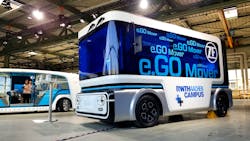Tomorrow’s mobility will be more focused on passenger comfort as electrification and automation continue to develop in the market. ZF Friedrichsharen AG recently held its Technology Day for media and Chief Executive Officer Wolf-Henning Schneider introduced its approach to next-generation mobility.
ZF is electrifying all types of vehicles and the autonomous driving functions will lower cost and increase safety.
Announced during the event was the joint venture of ZF with e.GO, a new mobility provider. The e.GO Moove GmbH, joint venture partners, manufacture people and cargo movers primarily for tomorrow’s urban mobility needs. Series production of these vehicles will begin in Aachen, Germany, in 2019.
The prototype vehicle was on display, featuring ZF’s full range of components: electric drive, AI, safety and chassis technologies.
Dr. Günther Schuh, founder and CEO of e.GO Mobile AG, said the people mover will provide the missing link in inner city traffic management. The size of a normal passenger auto, the e.GO Mover can hold 15 people — 10 seated, five standing — and is meant to support transit bus operation.
“We should provide solutions for more people wanting to live in cities,” said Schuh, explaining the concept behind the design. The vision entails parking on the outskirts of the cities with the focus in the cities being shared rides, as opposed to single-occupancy vehicles.
The biggest technical challenge for the e.GO Mover is training the system. Scheider said with ZF’s purchase of TRW, they have the sensors and technology to supply the complete system. While simulation plays a role in development, artificial intelligence will be the main driver and that will require training. “[AI] gives us the ability to reduce the millions of miles, but it still needs significant training so you have captured all the possible cases a number of times.”
While numerous companies are making electric autonomous shuttles, e.GO’s Thorsten Suaren explained a key distinction of the e.GO Mover: driver steering capabilities.
“The competitors are autonomous on a set track,” he said. “What we do, we teach, implement a corridor for a vehicle, and it figures out the best route for itself, like maneuvering around a car blocking its path.”
With a driver, the top speed is about 45 miles per hour, offering more flexibility of the vehicle’s use. The battery offers about 16 hours of operation on a charge and is designed for opportunity charging every four hours.
ZF also showcased automation in the delivery of goods and both those cases utilized a “driver” role, as well. ZF’s Gerhard Gumpoltsberger said there are many autonomous developments happening when it comes to parcel delivery, whether that’s by drone or small robot-like vehicles on the ground. Gumpoltsberger said there are countless ways to vision tomorrow’s future, they are further developing what they see as the best solution for their customers. Key to developing tomorrow’s mobility, he stressed, is balancing what the technology can do with what people will accept.



